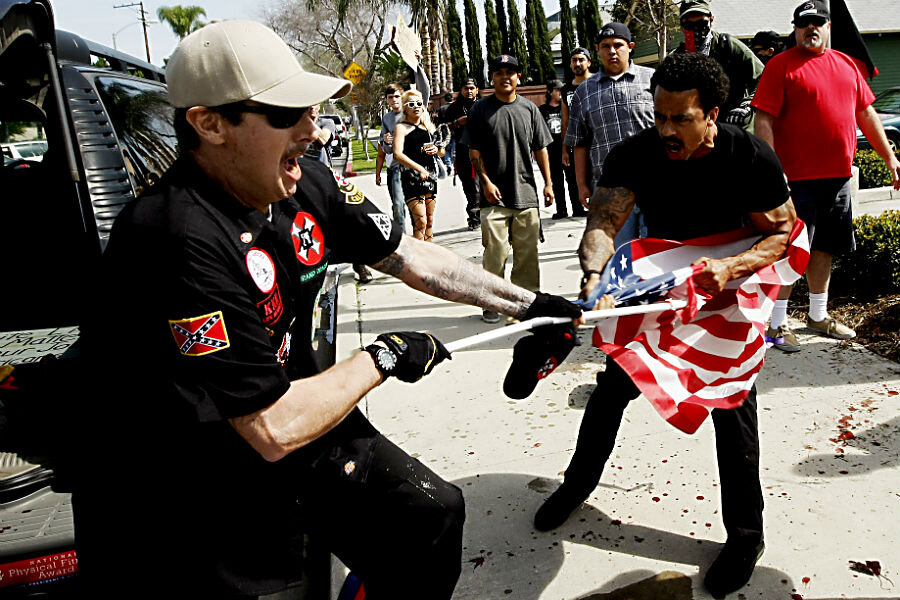How did police deal with KKK rally? Questions after California brawl.
Loading...
The Ku Klux Klan "have a right to their views and beliefs, but that doesn't mean they're welcomed here," Anaheim Mayor Tom Tait told hundreds of peace protesters Monday night.
In the wake of a Saturday rally that turned violent, members of the white supremacist group criticized police for insufficient protection. A lawyer for counter-protesters arrested at the melee has also blamed police, alleging that thin police presence hurt his clients.
Twelve people were arrested near Anaheim's Pearson Park on Saturday afternoon after three counter-protesters at a planned KKK rally were stabbed by Klansmen. Police later released all five Klan members taken into custody, saying they were acting in self-defense after counter-protesters attacked them. Seven people were arrested for beating and stomping on KKK members.
Will Quigg, a leader of the West Coast section of the Loyal White Knights, a major KKK group, accused officers of refusing to provide protection when the group informed them about the rally ahead of time. "We don't do that," Mr. Quigg says police told him. He told reporters that Anaheim police also refused to let the KKK hire their own security guards.
On video, someone is seen kicking Quigg in the face. He said his right hand is fractured, and that he has a bruised rib and spleen. "What was done was done to protect our lives?" he asked, adding that he had not stabbed anyone. "Our lives were in jeopardy."
Some witnesses have said that they did not see officers present at the start of the confrontation around noon. A video shows officers arriving minutes after Klansmen were attacked, according to the Los Angeles Times.
Anaheim Sgt. Daron Wyatt said that officers believed the KKK was asking for personal security guards, and were unwilling to pay for that service. Police have said that officers were present from the start, and called for backup, which arrived within minutes, when the violence began.
A lawyer for three counter-protesters arrested Saturday claims his client Hugo Contreras' arm was broken as police took him into custody, and that the three were trying to restrain, not attack, a Klansman who had stabbed someone.
"He's treated like a dirty filthy criminal, and then [the police] are very polite and civil to these KKK guys, who have stabbed three people. All Mr. Contreras did was try to help his friend," lawyer Thomas Kielty told the Los Angeles Times. "It was almost like this was set up in part by the police, for not showing up."
Several dozen counter-protesters had gathered near the park before the rally, most peaceful. A small group, however, "specifically came there to commit acts of violence, and there is nothing to do to stop that," Sgt. Wyatt said. The department has not specified how many officers were present during the fight.
"Regardless of an individual or groups' beliefs or ideologies, they are entitled to live without the fear of physical violence and have the right, under the law, to defend themselves when attacked," the police department said in a statement. Klansmen arrested Saturday were later released, after police concluded that they had acted in self-defense.
Up to 300 people joined Mayor Tait, former California Sen. Lou Correa, and Anaheim Union High School District superintendent Michael Matsuda in a march for peace Monday night, as they made their way from the park to City Hall, chanting "This is what democracy looks like. This is what peace looks like. This is what Anaheim looks like."
Anaheim, once a stronghold of the KKK, is today more than 50 percent Latino and 15 percent Asian.
"We must show everyone not to fight fire with fire. Fight fire with love and compassion," Mr. Correa, formerly D-Santa Ana, told the crowd.
Speakers encouraged the marchers to continue peacefully fighting to "tear down more walls that divide us," as Mirvette Judeh Maaytak said. Ms. Judeh, an Arab American Caucus board member, reminded listeners to bring their views to the ballot box. "What this country is based on is freedom, and day by day, we are free to work to eliminate hate," she said.
This report includes material from the Associated Press.








